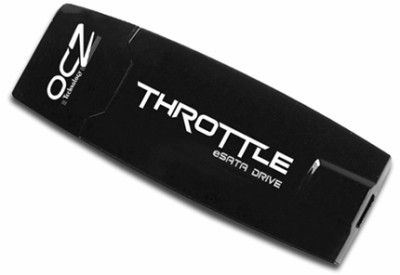From our front-page news:
When USB-based thumb drives first came out, they were an object of envy. But, initial prices were rather ridiculous. The first one I ever had was a "freebie" from Dell with the purchase of an overpriced notebook (at the time). At 64MB, I couldn't really do much with it, except store very small files, but hey, it still came in handy at the oddest of times.
Because of the sheer popularity of these things, it's hard for companies to differentiate themselves from the crowd. The top-end speeds were hit a while ago (due to USB 2.0 limitations), and there's only so many different styles before things become a bit boring. Well, OCZ is trying to change things up, and might do so with their eSATA "Throttle" flash drive, which, as you probably guess, utilizes the eSATA port on your desktop or notebook.
Thanks to the connection, Read speeds are clocked at 90MB/s, while Write speeds remain the same as a typical USB thumb drive, at 30MB/s Write. Surely, most people would prefer faster Write speeds, but it sure doesn't seem to be happening with the current flash chips available... at least at this price-range.
What would interest me, though, is booting an OS from this thing. People are already doing that with their USB drives, but with 3x the overall Read speed, theoretically, it should almost be as fast as a mechanical hard drive. This would also depend on whether or not your motherboard could boot from eSATA, but chances are good that it would be able to. Interesting product nonetheless.

The OCZ Throttle eSATA drive offers performance and versatility for enthusiasts that demand the best hardware. The integration of eSATA connectivity now extends beyond desktop systems to laptops, offering increased data transfer rates with extreme portability while eliminating extra cords and power cables.
Source: OCZ Throttle Product Page
Because of the sheer popularity of these things, it's hard for companies to differentiate themselves from the crowd. The top-end speeds were hit a while ago (due to USB 2.0 limitations), and there's only so many different styles before things become a bit boring. Well, OCZ is trying to change things up, and might do so with their eSATA "Throttle" flash drive, which, as you probably guess, utilizes the eSATA port on your desktop or notebook.
Thanks to the connection, Read speeds are clocked at 90MB/s, while Write speeds remain the same as a typical USB thumb drive, at 30MB/s Write. Surely, most people would prefer faster Write speeds, but it sure doesn't seem to be happening with the current flash chips available... at least at this price-range.
What would interest me, though, is booting an OS from this thing. People are already doing that with their USB drives, but with 3x the overall Read speed, theoretically, it should almost be as fast as a mechanical hard drive. This would also depend on whether or not your motherboard could boot from eSATA, but chances are good that it would be able to. Interesting product nonetheless.

The OCZ Throttle eSATA drive offers performance and versatility for enthusiasts that demand the best hardware. The integration of eSATA connectivity now extends beyond desktop systems to laptops, offering increased data transfer rates with extreme portability while eliminating extra cords and power cables.
Source: OCZ Throttle Product Page
